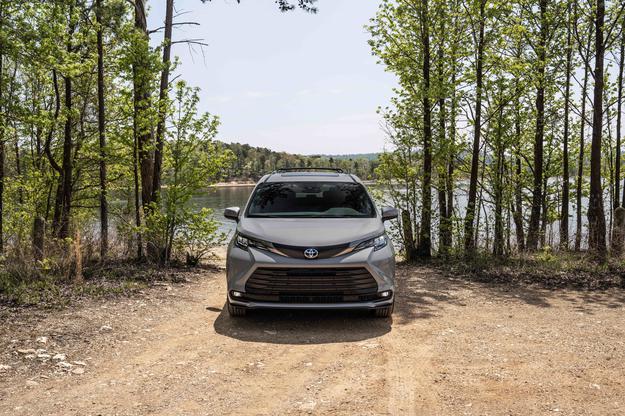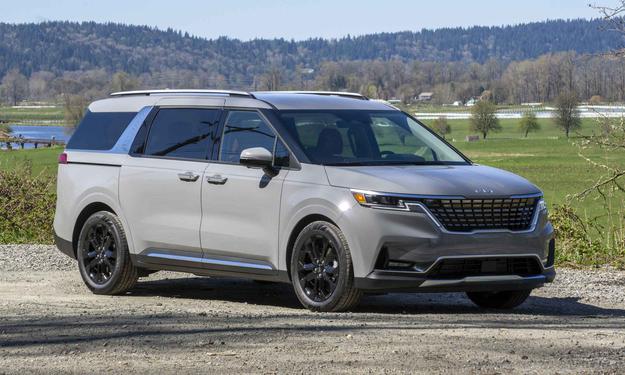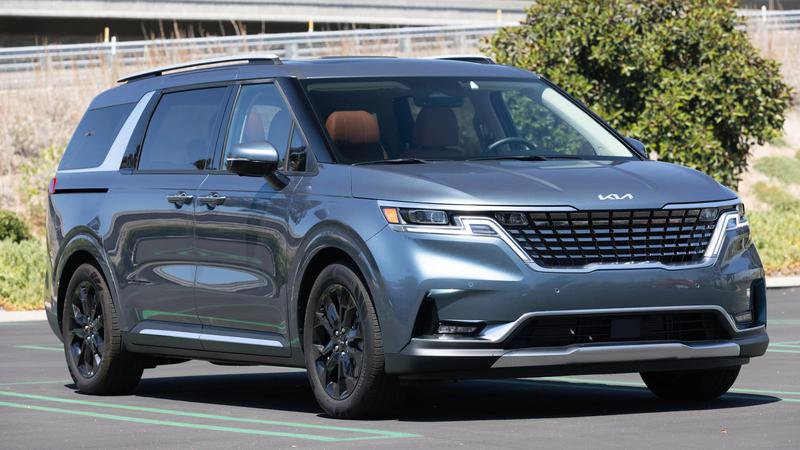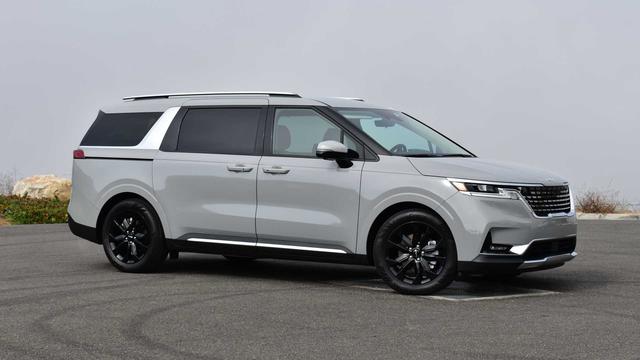Minivans can be super adventure vehicles and can be great platforms for life on the road. Yes, you read that right — minivans.
While overlooked by many, a minivan’s inherent practicality, versatility, affordability, and comfort rank among the top for any vehicle. If you’re willing to let go of your preconceived stereotypes and explore options for a smaller adventure van, you might just find some dang good minivan options out there.
So, which are the best? Here are my top five minivans for life on the road.
5 Minivans for Road Life
The Toyota Sienna is probably not what you think of when you hear “life on the road.” However, these vans have a reputation for longevity, reliability, and dependability.
Whether it’s an early model from the late 1990s, or the top-of-the-line AWD hybrid variants sold new today, the Sienna is gaining traction among vanlifers and adventure travelers.
In fact, Toyota has taken note of this and now offers the Woodland variant for 2022. The Sienna Woodland turns this minivan into more of an SUV thanks to increased ground clearance. Granted, it’s only an additional 0.6” of clearance, but more is more.
You also get roof rails with crossbars, a 1,200-watt JBL stereo, and an AC power outlet for most household items. Toyota will also donate $250 to the National Environmental Education Fund (NEEF) for every Woodland edition sold, too.
The Sienna also comes in a Hybrid trim with AWD and offers 35 combined mph. The van’s rear seats fold into the floor for extra space and versatility, and the interior is plush and ultracomfortable.
So, you’re ready to buy an adventure vehicle? Awesome! Let’s look at 4WD vs. AWD and how to choose the right one for your new adventure rig. Read more…
But say you’re not looking to spend $50,000 on a new AWD Sienna. There are loads of older versions available at much lower prices. This can allow you to focus more on building the van’s interior out the way you want.
A Sienna isn’t going to be as capable as an SUV, but that doesn’t mean you’re relegated to the tarmac. There are aftermarket manufacturers that are actually making small lift kits for these vans, allowing them to be fitted with bigger all-terrain tires so you don’t just have to stick to the highways. You’ll also be able to get to more trailheads, kayaking spots, or more remote campsites, too.
With its reputation for reliability, a spacious versatile interior, and plenty of creature comforts, the Sienna is a great choice for those looking for a dependable, versatile minivan.
Now on its second generation in North America, the Ford Transit Connect is a minivan that can also double as a super travel setup. If any of the vans on this list are “sporty,” the Transit Connect would be the driving enthusiast’s choice.
They handle better than anticipated and while they’re not exactly a sports car, they can be fun to drive. And, since you can buy these vehicles pretty much any way you want from the factory (including with or without rear seats or windows), they offer up a blank canvas for mini-vanlife.
These vehicles first showed up in the U.S. as a 2009 model (earlier versions were sold in Europe), and they’re easy to find used and relatively inexpensively. However, even if you opt for a brand-new version, they’re all going to be front-wheel-drive, so it’s best for on-road or dirt-road travel only.
But if you’re sticking to highways and byways, it can be a great travel platform. The 2014–current Transit Connects comes in two lengths. The long-wheelbase version is probably the best for life on the road.
There are several companies building these into campers, including Ursa Minor, a Portland, Oregon-based outfitter that makes a pop-top version for long-wheelbase versions of the 2014+ Transit Connects.
Transit Connects are all powered by four-cylinder engines, with older versions getting a 2.5L non-turbo powerplant. Newer ones have either the 2.5L or a 2.0L mill for more power. (A 1.6L EcoBoost turbo was briefly available, too, but are rare.) While they’re not rocketships, they do offer respectable fuel economy.
The combination of these minivan’s utility, driving dynamics, and availability make them a good platform for life on the road. Plus, the extensive network of Ford dealers means parts and service are easy-peasy.

The Mitsubishi Delica was originally launched in the 1960s. The name is a portmanteau of “delivery” and “car.” However, it didn’t really become an iconic van until the 1986 Delica Star Wagon came along.
That van, which was never sold in North America, paired a unibody car chassis with a rugged 4WD system — complete with a low-range four-wheel-drive system that enabled it to go anywhere. There were a dizzying array of versions: low roof, high roof, glass tops, winter-themed Chamonix versions, models with bull bars, bench seats, captain’s seats, even 12-volt coolers.
In 1994, the Delica Space Gear came out. It got a more rounded-off minivan shape but didn’t lose its versatility, capability, or ability to become a great camper or travel vehicle. These vans also offered a few different gasoline or turbodiesel engines.
The Star Wagons were pokey, but can still cruise at 65 mph (it just takes a while to get there). Space Gear models (post-1994) offered up more powerful 3.0L V6 engines or 2.8L turbodiesel that are much more comfortable cruisers.
While the Mitsubishi Delica was never officially sold in North America, they can be imported into the U.S. as long as they’re 25 years old or more, and are easily registered in most states. (Maine and Rhode Island are currently the exceptions.)
The combination of versatile interior dimensions, available overbuilt driveline components, and the fact they were sold globally makes the Delica a great choice for life on the road. Perhaps the best vanlife setup would be a 1994+ Delica Space Gear with the 2.8L turbodiesel, a high-roof setup, with the long wheelbase.
Foreign-market vehicles aren’t without some challenges. Parts can be harder to get than your run-of-the-mill minivans. However, Canada has a number of great shops that often have parts on hand. (Canada has a 15-year import rule, so these vans have been there longer than the U.S.)
Some parts, such as brake pads and rear brake rotors, are the same as Mitsubishi’s Montero SUV, which was sold in the U.S. For many, however, the Delica’s pros outweigh the cons, and these quirky minivans remain a darling of the overland travel set globally. In fact, I own the 1994 Delica Space Gear pictured here.
This almost goes without saying, but the Volkswagen Vanagon is a classic. Available in 2WD and 4WD versions (called Syncros), the Vanagon — especially when equipped with a pop-top camper, such as a Westfalia — is one iconic minivan. These vans have their roots tied to the original Microbus, which is the grandaddy of minivans. People were using these for vanlife well before vanlife was a thing.
Vanagons have been the darling of travelers worldwide for decades. Customized 4WD Syncro versions command a premium — sometimes well into the $70,000 range — due to their go-everywhere capability and high-end camperized interiors.
There are scads of these that have been turned into adventuremobiles over the years, with the best-known customs being done by Westfalia. But even 2WD versions can be expensive, but it’s a proven platform with lots of aftermarket support.
The Vanagons aren’t known to be quite as reliable as some of the Japanese vans, but they have their own rugged personality and capability. Of all the vans on this list, this is the model with the most experience with campers living out of them.
Depending on where you live, these vans have over 20 model years to choose from, with a myriad of engine choices. None are going to be particularly rapid, but there’s an ultra-loyal community of Vanagon owners globally, many of which are more than willing to lend a hand if needed.
For those looking for more thrust, some owners even swap out the old VW engines for more modern and powerful Subaru powerplants to wake these German vans up from a performance perspective.
The Vanagon is a timeless classic; a minivan before minivans were, well, minivans. If one vehicle personified life on the road on this list, the Vanagon would be it.
I recently spent a week with a new Chrysler Pacifica Hybrid and I have to say, I was totally surprised and impressed by this vehicle. I grew up with a mid-’80s Dodge Voyager and rode in a 1990s Chrysler Town & Country from Minnesota to Mexico City in 1994. This is not the Chrysler van of yore with fake woodgrain and cheesy hubcaps. Pacificas are roadtrip machines!
The latest 2017–current Pacificas offer extraordinary levels of comfort and livability. Like the Sienna, the rear seat tumbles into the floor. The middle captain’s chairs can be completely removed opening up the Pacifica’s interior into a gargantuan place to camp, hang out, or do whatever vanlifers do.
I was able to remove those seats, lay out a double-wide sleeping bag, and still had scads of room for gear. I could even watch TV or play games on the monitors located in the front seats’ headrests! Plus, my Hybrid model had a panoramic glass roof, which would be amazing for stargazing.
Add to it front seats that were heated and air-conditioned and ultra-comfortable, and a world-class infotainment system, and you’ve got one heck of a vehicle that just happens to be a minivan.
The more time I spent in the van, the more I thought about how it could be a great full-time travel vehicle with the right buildout inside. Even if you went barebones with an interior build, this thing was so good on the highway — and comfortable, too! The miles just passed by without fatigue or anything.
The fact the Hybrid model gets up to 82 MPGe or 30 mpg on gasoline isn’t bad, either. If you have to have AWD, there’s a Pacifica for you, too. It’s powered by a 3.6L V6 making 287 horsepower. Fuel economy isn’t hybrid-like, but it does offer up that AWD capability. And yes, you can find small lifts for more ground clearance and larger tires.
Chrysler was the originator of the modern minivan as we know it. And after driving the new Pacifica, I’d say they’ve still got it.




